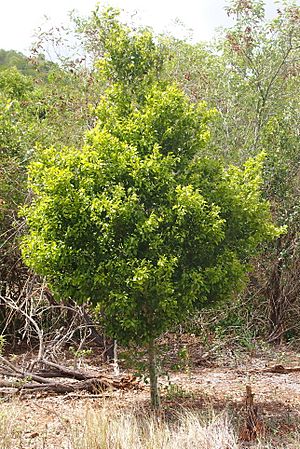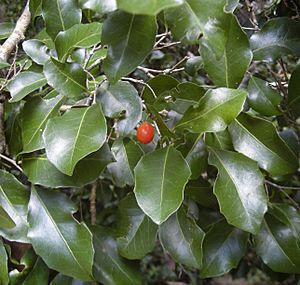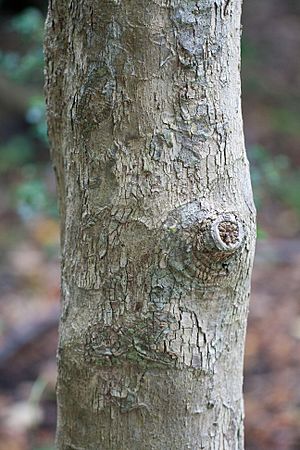Yellow tulip facts for kids
Quick facts for kids Yellow tulip |
|
|---|---|
 |
|
| Drypetes deplanchei | |
| Scientific classification | |
| Genus: |
Drypetes
|
| Species: |
deplanchei
|
| Synonyms | |
|
|
The Drypetes deplanchei is a tree found in eastern and northern Australia. You can also find it in New Caledonia and on Lord Howe Island. Its scientific name, Drypetes, comes from a Greek word meaning "olive fruit." The species was named after Dr. Emile Deplanche, who first collected this plant in New Caledonia. People often call this tree by other names like yellow tulip, grey boxwood, white myrtle, grey bark, and yellow tulipwood.
Contents
Where it Grows: Distribution and Habitat
This tree grows quite far south, reaching the Hunter River in New South Wales. It stretches north all the way to the Torres Strait, across the Top End of the Northern Territory, and into The Kimberley in Western Australia. A special type of this tree, called affinis, only grows on Lord Howe Island.
You can find the yellow tulip tree in different places. It often grows in monsoon forests and drier rainforests. It also likes to grow near the coast in what's called littoral rainforest, and along streams.
What it Looks Like: Description
The yellow tulip tree is usually small to medium-sized. It can grow up to 25 meters (about 82 feet) tall. Its trunk can be as wide as 60 centimeters (about 2 feet). The bottom part of the trunk often looks wider or has ridges.
The bark is grey or brown. Pieces of the bark often fall off, leaving small dents. This makes the trunk look patchy or mottled, a bit like the tulipwood tree. Older trees have scaly and bumpy bark. The smaller branches are smooth, thin, and grey. They have many tiny dots called lenticels, which help the tree breathe.
Leaves
The leaves are shaped like ovals or eggs. They are usually 4 to 9 centimeters (1.5 to 3.5 inches) long and 1 to 5 centimeters (0.4 to 2 inches) wide. They feel stiff and thick, and their edges can be wavy, smooth, or slightly scalloped. The base of the leaf tapers quickly, and the tip can be pointed or rounded.
The leaves are smooth and shiny green on top, and a bit lighter green underneath. The leaf stems are short, about 3 to 6 millimeters long. Young leaves have very noticeable teeth along their edges. You can easily see the leaf veins, which stick out on both sides of the leaf. There are usually five to seven main side veins that branch off the middle vein at an angle of about 65 degrees.
Flowers and Fruit
Yellow-brown flowers appear in November. They grow from where the leaves join the branches. This tree has separate male and female flowers, meaning they grow on different trees. Each flower is small, about 4 millimeters across.
The male flowers grow in small clusters. They have tiny leaf-like parts around 2 millimeters long and 5 to 10 stamens (the parts that make pollen). The female flowers grow alone or in small groups of 3 or 4.
The fruit is a bright red, juicy drupe. It is 12 to 20 millimeters (about 0.5 to 0.8 inches) long. Inside, it has moist yellow flesh. There is usually one seed, which is about 12 millimeters long and oval-shaped with a groove on one side. The fruits ripen from February to April. Birds like the emerald dove, topknot pigeon, and wompoo fruit dove enjoy eating them. Growing new trees from these seeds can take a long time.
How People Use It: Uses
In the past, people in the Richmond River area of northern New South Wales used the wood from this tree to make handles for bullock whips.
Indigenous Australians ate the fruit raw. They also used the leaves in cooking and carved the wood for various purposes.
Early settlers on Lord Howe Island used the wood for sea piles (posts driven into the seabed). They found that the sap from the tree helped protect the wood from marine worms.
Its Role in Nature: Ecology
The yellow tulip tree is a food source for many insects. For example, the caterpillars of the common albatross butterfly eat its leaves. It might also be a food source for the very rare Lord Howe Island stick insect.



